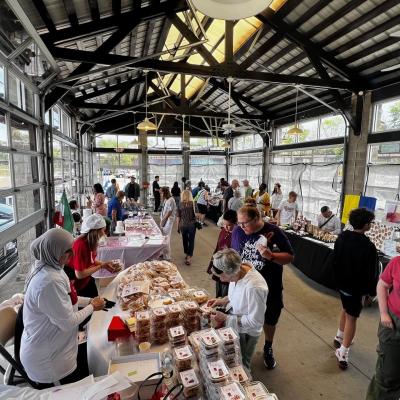
More people than ever before are avoiding gluten so you may have wondered if you should, too. Here are the basics to catch you up to speed.
What's the Big Deal with Gluten-Free?
If you've gone grocery shopping, visited any health-related websites, or talked to the most ardent of your diet-trend following friends in the past few years then you've probably heard of gluten. More people than ever before are avoiding gluten so you may have wondered if you should, too. Here are the basics to catch you up to speed:
What is Gluten?
Gluten is a protein found in wheat that is highly nutritious. By itself, it can be made into seitan, which is a firm-textured meat substitute. Lucky's has a great seitan gyro, if you're gluten-curious.
So it's a protein...why am I avoiding it again?
Some people have a condition called Celiac Disease that causes sufferers to have severe reactions to ingesting gluten including nausea, vomiting, headaches, etc. Over time, consistent exposure to gluten will cause Celiacs to become unable to absorb nutrients at all, causing malnourishment and potentially even death. The treatment for this disease is often an absolute avoidance of anything that could have even interacted with gluten because even the slightest amount could cause a severe reaction.
Some other people have gluten sensitivity, which means they suffer occasional symptoms when exposed to gluten but these symptoms are usually not as severe and where Celiacs can have a severe reaction to a very small amount of gluten, gluten sensitives typically can handle gluten exposure at low levels. Doctors will often have patients presenting vague symptoms of unease try a gluten free diet to see if that could be a cause. Most people in this category just have to try to avoid gluten as much as possible.
Most people can digest gluten just fine, which is why wheat is a staple crop for us in the United States and many other countries.
Bottom line, is Gluten bad for you?
If you fall into the 90% of the population that is neither Celiac nor gluten sensitive, no, gluten is not bad for you.
But gluten isn't on my Paleo diet! If cavemen didn't eat it, I won't eat it.
I assure you with every single credit in my otherwise pretty useless Anthropology degree - the people of the Paleolithic era ate whatever was available that didn't kill them first.
Will a Gluten Free diet help me lose weight?
It depends. If you simply cut out the foods that contain gluten (breads, cookies, cakes, etc.), you would also be avoiding many foods that are high in carbohydrates by default and many people lose weight by cutting back on carbs. If you replace these foods with their gluten free counterparts at the store (i.e. gluten free breads, gluten free cookies, etc.) then you will still be getting the carbs and fats from these foods and you probably won't experience any change.
Bringing it Back to Dayton
If you think you'd like to try a gluten free diet, you may think that you can only cook meals at home. Lucky for you, local Dayton restaurants have you covered! Lucky’s Taproom & Eatery in the Oregon District offers some gluten free items on their breakfast and dinner menus. Olive, an Urban Dive often includes gluten free options in their offerings – yes, even desserts! Butter Café almost always has gluten free cupcakes or other treats in their case and also offers gluten free options in their menu. And for the full gluten free experience, check out Sinfully Gluten Free in Centerville – they have a restaurant and also sell several gluten free products to enjoy at home.
Wheat Penny has a name that brings gluten immediately to mind but they actually offer a gluten free pizza crust. I spoke with Wheat Penny's Head Chef, Liz Velenti, about gluten and why it's important to both Wheat Penny and it's mother, Meadowlark (where she worked previously) to offer variety.
Lauren Rinehart: When and why did Wheat Penny decide to offer a gluten free option?
Liz Valenti: From the very beginning - Meadowlark was and is always committed to the customer experience so has always offered menu options to accommodate as many dietary issues as possible. When Wheat Penny's menu was being developed, it was important to us to offer a diverse, local, and flexible menu for our customers.
LR: Do you think local businesses that are offering gluten free options have the edge right now in the market?
LV: Thanks to the internet, we now have a lot of conversation going on about what customers are looking for in their local restaurants. This gives restaurant owners and chefs the chance to get direct feedback and to help remain as customer focused as possible. The restaurants that make customers their main focus can therefore earn reputations for doing so.
LR: How do you create a gluten free dining experience?
LV: I was trained in pizza school in San Francisco and while I was there, I learned about creating pizza crust using gluten free ingredients such as gluten free beer, rice flour, chickpeas, etc. We feel that the integrity of the food is very important so we had to make our gluten free crust as good as our regular crust.
LR: If gluten suddenly stopped being a hot topic, would you continue to offer gluten free options on your menu?
LV: Yes, because people will still have gluten issues and it's our goal to give every customer a great dining experience no matter their dietary restriction.
But how does it taste?
I tried the gluten free crust for the first time a few days ago, and I loved it! I was expecting something similar to gluten free breads that I've tried, which all have a grainy texture and disintegrate easily. Wheat Penny's GF crust is chewy, flavorful, and definitely like many homemade crusts I've tried - no strange-tasting crumbling styrofoam here! I honestly couldn't believe it was gluten free.
For more information on Wheat Penny or Meadowlark, click the respective links. For more information on gluten, scroll down to watch an informative (and quick) video.


















